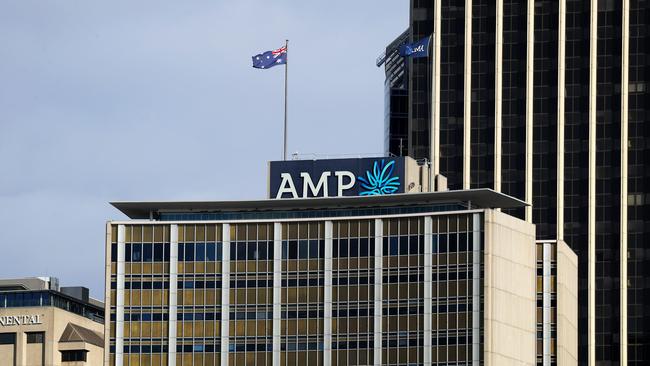Shareholders call on AMP to supercharge capital return
The wealth manager plans to stage the shareholder windfall through the 2023 financial year. But shareholders say they want at least another $500m.
Shareholders are calling for AMP to supercharge its capital return program rather than seek out fresh acquisitions, saying they expect to receive substantially more than the $1.1bn the wealth manager has already flagged.
ASX-listed AMP on Thursday said shareholders were in line for the billion-dollar windfall following a series of recent asset sales, including its infrastructure debt platform, a stake in Resolution Life Australasia and Collimate Capital, with the first stage of the staggered program to kick off immediately through a $350m on-market share buyback.
A further $750m of capital returns are planned for the next year, subject to regulatory and shareholder approval, and will be made up of a special dividend, a further on-market share buyback, or a combination of both.
But shareholders say they want more, and that the money is better off with them rather than the wealth manager, given its track record on bolt-ons.
“AMP will receive net proceeds of over $2bn from the sale of (Resolution) Life and Collimate Capital if it all completes to plan and we certainly would like to see an amount closer to that returned to shareholders,” Allan Gray analyst Tim Hillier told The Australian.
“They’ve said they’re considering these inorganic growth opportunities, but we have very little appetite for them to put a lot of capital into acquiring other businesses. We would far rather they continue focusing on interesting challenges in the existing business.”
Australian Eagle Asset Management senior portfolio manager Alan Kwan said he was expecting “at least another $500m” in capital returns once the Collimate Capital sales complete in September and November.
“Honestly, AMP’s track record has been mixed on the acquisition front. It depends on what they’re looking at but at this point in time (the proceeds) are probably better off in shareholders’ hands than theirs.”
AMP announced the shareholder windfall as it handed down its first-half result, which showed its underlying after-tax profit slipped by a quarter to $117m, down from $155m the year prior, due in part to repricing of its North and Master Trust platforms and a near 50 per cent profit slump in its banking operations.
The stock initially sank 3 per cent in early trade on Thursday before paring some of the losses to close down 0.86 per cent at $1.16.
Statutory after-tax net profit jumped to $481m in the half, up from $146m in the prior corresponding period, following the sale of its infrastructure debt platform.
“We have built strong momentum on the transformation of AMP into a simpler and more efficient organisation which is well placed to grow.
“The agreed sales of the Collimate Capital businesses are on track to complete in the second half of the year. Post completion there will be a renewed focus for AMP as a leading wealth management and banking business in Australia and New Zealand,” AMP chief executive Alexis George said.
AMP sold its funds management division earlier this year after it changed the name of the business from AMP Capital to Collimate Capital and scrapped a planned float.
DigitalBridge bought the infrastructure arm for up to $699m, while Collimate’s real estate and domestic infrastructure equity business was sold to Dexus Property for up to $325m.

But she also flagged that the wealth manager was looking for bolt-ons to boost the business, and may hold aside $400m to spend on acquisitions.
“Scale is important to us, as is capability, particularly in that digital and data space where we need to be better,” Ms George said.
“We’re in a position where some of the asset values have come off so we’ll just be very diligent about looking at them.”
Chief financial officer James Georgeson noted a further capital return was still on the table, depending on whether M&A opportunities arose or not.
Australian Eagle’s Mr Kwan said the main positive from the result was that losses were shrinking in the advice business. He said he was slightly disappointed with AMP Bank’s performance, especially on the margins.
The bank saw its underlying profit tumble 45 per cent in the half, from $84m to $46m, as net interest income declined. The prior corresponding period’s result was also boosted by the release of a one-off $12m credit loss provision.
AMP’s residential mortgage book grew at 1.15 times system in the half — far less than the 2 times system it was aiming for at the start of the year — in what the wealth manager described as challenging market conditions.
The squeeze on its net interest margin continued, with the NIM falling to 1.32 per cent, but it showed signs of improving in the second quarter as interest rates pushed higher. AMP said it expected the NIM to recover further through the rest of the year, AMP said.
Assets under management in its Australian wealth business slipped to $126.3bn, down from $142.3bn, as investment market returns turned negative, but Allan Gray’s Mr Hillier said the result showed the division’s progress.
“You’re starting to see cost savings reflected in the numbers and they’re offering more competitive prices on their products. But, really, for it to be a success you want to see inflows into that business rather than outflows. Ultimately that’s what we like to see.”
Its North platform benefited from $1.3bn in net cashflows, helping to partially offset the impact of negative markets, but was dragged down by its Master Trust platform, which suffered net cash outflows of $1.6bn.
UBS analyst Scott Russell said first impressions of the result were mixed, with the capital return coming earlier than expected versus a disappointing core business result that included a big miss on the underlying profit.
“Underlying earnings are below our forecast and contain evidence of ongoing revenue margin squeeze and rising cost ratios in both wealth and bank,” Mr Russell said.
“Second quarter net outflows were not as bad as previous quarters as North (platform) gathers traction with independent financial advisers.”
UBS had been expecting underlying profit of $128m, below the consensus expectation of $131.5m but still well above the $117m reported by AMP.
Analysts at Ord Minnett earlier this week flagged the potential for a $1bn shareholder payday, estimating AMP would have $1.8bn of surplus capital post asset sales.
“In the short run there will be benefits from capital returns, although in the medium term we believe (AMP) faces significant risk in executing a cost-reduction program to offset revenue margin pressures,” the analysts cautioned as they slashed their target price on the stock from $1.25 to $1.10 a share.
In line with prior guidance, no interim dividend will be paid to shareholders.






To join the conversation, please log in. Don't have an account? Register
Join the conversation, you are commenting as Logout